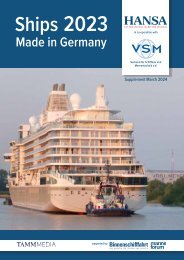HANSA 06-2019
Reparatur & Umbau | Start-Ups | COMPIT Review | CIMAC 2019 | Terminaltechnik | Batterien & Hybrid | Offshore-Flotte | U.A.E. | Cruise Ship Interiors | Zeaborn & Offen
Reparatur & Umbau | Start-Ups | COMPIT Review | CIMAC 2019 | Terminaltechnik | Batterien & Hybrid | Offshore-Flotte | U.A.E. | Cruise Ship Interiors | Zeaborn & Offen
Erfolgreiche ePaper selbst erstellen
Machen Sie aus Ihren PDF Publikationen ein blätterbares Flipbook mit unserer einzigartigen Google optimierten e-Paper Software.
Schiffstechnik | Ship Technology<br />
Figure 1: Pressure as a function of cylinder volume for an engine with a maximum cylinder pressure of 150 bar<br />
valve is opened. The fuel energy released<br />
in this way is most efficiently<br />
converted to mechanical energy, which<br />
is delivered to the piston.<br />
••<br />
Late part of the fuel injection profile:<br />
fuel is injected and burned after the piston<br />
has left TDC. The cylinder volume<br />
is larger at this time and the combustion<br />
gasses resulting from burning this portion<br />
of the fuel will not expand and cool<br />
to the same degree as earlier. The energy<br />
in this portion of the fuel is less efficiently<br />
converted to mechanical energy.<br />
We want to inject and burn the fuel<br />
quickly to achieve the highest efficiency<br />
and power output. This is limited by the<br />
maximum cylinder pressure that the engine<br />
can withstand. Thus, it is important<br />
to have an engine that is designed for a<br />
high maximum cylinder pressure as can<br />
be seen in Figures 1 and 2. In Figure 1,<br />
combustion – and thereby heat release<br />
– continues until the cylinder volume<br />
is 0.28 times the maximum cylinder<br />
volume. The last portion of fuel that is<br />
burned can therefore expand by a ratio<br />
of 1.00/0.28 = 3.6. Compare this to the<br />
200bar engine illustrated in Figure 2.<br />
In Figure 2, the same amount of fuel has<br />
been injected as in Figure 1, but fuel injection<br />
and combustion can occur faster than<br />
in Figure 1 without exceeding the maximum-allowable<br />
engine cylinder pressure.<br />
Combustion and heat release finish at a<br />
cylinder volume of 0.22 times the maximum<br />
cylinder volume, which results<br />
in a higher expansion ratio of 1.00/0.22<br />
= 4.5 for the last portion of fuel burned.<br />
This means that more of the chemical energy<br />
in the fuel is extracted as mechanito<br />
achieve high engine efficiency and power, it is important to have an engine that is designed for a<br />
high maximum cylinder pressure; see Figure 1 and Figure 2.<br />
In Figure 1, combustion – and thereby heat release – continues until the cylinder volume is 0.28 times<br />
the maximum cylinder volume. The last portion of fuel that is burned can therefore expand by a ratio<br />
of 1.00/0.28 = 3.6. Compare this to the 200 bar engine illustrated in Figure 2.<br />
© MAN<br />
Pressure as a function of cylinder volume for an engine<br />
Figure 1: Pressure as a function of cylinder volume for an engine with a maximum cylinder pressure of 150 bar<br />
with a maximum cylinder pressure of 150 bar<br />
In Figure 1, combustion – and thereby heat release – continues until the cylinder volume is 0.28 times<br />
the maximum cylinder volume. The last portion of fuel that is burned can therefore expand by a ratio<br />
of 1.00/0.28 = 3.6. Compare this to the 200 bar engine illustrated in Figure 2.<br />
Pressure as a function of cylinder volume for an engine<br />
with a maximum cylinder pressure of 200 bar<br />
Figure 2: Pressure as a function of cylinder volume for an engine with a maximum cylinder pressure of 200 bar<br />
However, determination of the overall<br />
efficiency effects of changes of the engine<br />
type and layout is not as straightforward<br />
and is the focus of this article.<br />
The combustion engine’s basic job is<br />
to burn fuel in a small volume and subsequently<br />
expand the resulting, hot,<br />
high-pressure combustion gases to a<br />
larger volume, while delivering power<br />
to that part of the combustion chamber<br />
wall that provides the expansion<br />
– namely the piston. It should be understood<br />
that a high expansion ratio is<br />
important in order to achieve high engine<br />
efficiency. That is, the greater the<br />
extent that the hot gasses can be expanded<br />
and cooled before the exhaust<br />
valve is opened, accordingly the more<br />
energy can be extracted from the gases<br />
and the higher the engine efficiency<br />
and the colder the exhaust gas will be.<br />
Figure 2: Pressure as a function of cylinder volume for an engine with a maximum cylinder pressure of 200 bar<br />
Derating<br />
In principle, it would be ideal to burn the<br />
fuel in a volume so small that the hot,<br />
high-pressure combustion gasses could<br />
expand until the cylinder pressure reached<br />
atmospheric pressure before the exhaust<br />
valve was opened. This is not feasible for<br />
a number of reasons that are outside the<br />
scope of this article. However, it is relevant<br />
to mention that if such small combustion<br />
chambers were used, it would reduce the<br />
amount of oxygen in the chamber unless<br />
the pressure was very high – higher than<br />
possible from an engine-design point of<br />
view.Accordingly, a small combustion<br />
chamber means a reduced amount of oxygen,<br />
which itself means that it is not possible<br />
to burn as much fuel. The result is<br />
a lower engine torque and thereby lower<br />
power-output. Despite this, the chamber<br />
volume is often reduced to some extent<br />
– this is called derating. A derated, marine<br />
two-stroke engine has a combustion<br />
chamber that is smaller than a fully-rated<br />
version of the same engine type and this<br />
is done to increase the expansion ratio,<br />
and thereby the efficiency of the engine,<br />
at the expense of a lower power-output.<br />
High maximum cylinder-pressure<br />
In the previous explanation, it was assumed<br />
that all the fuel is burned when<br />
the cylinder volume is at its smallest, at<br />
the position in the engine cycle called<br />
TDC (Top Dead Centre). In terms of engine<br />
efficiency, it would also be beneficial<br />
to burn all the fuel at TDC.<br />
In an engine in operation the fuel cannot<br />
all be delivered and burned at once.<br />
Even if possible, it would result in cylinder<br />
pressures that were too high. The fuel<br />
is therefore injected following a carefully<br />
designed injection profile. This gives a<br />
high engine efficiency and power output<br />
without exceeding the physical limits of<br />
the engine and other restraints such as<br />
exhaust-emission requirements. In order<br />
to better understand the positive effect on<br />
fuel consumption of an engine that can<br />
withstand a high maximum cylinder<br />
pressure, let’s take a look at the fuel-injection<br />
process:<br />
••<br />
Early part of the fuel-injection profile:<br />
fuel is injected and burned near TDC<br />
and will expand and cool to the greatest<br />
possible extent before the exhaust<br />
<strong>HANSA</strong> International Maritime Journal <strong>06</strong> | <strong>2019</strong><br />
57


















